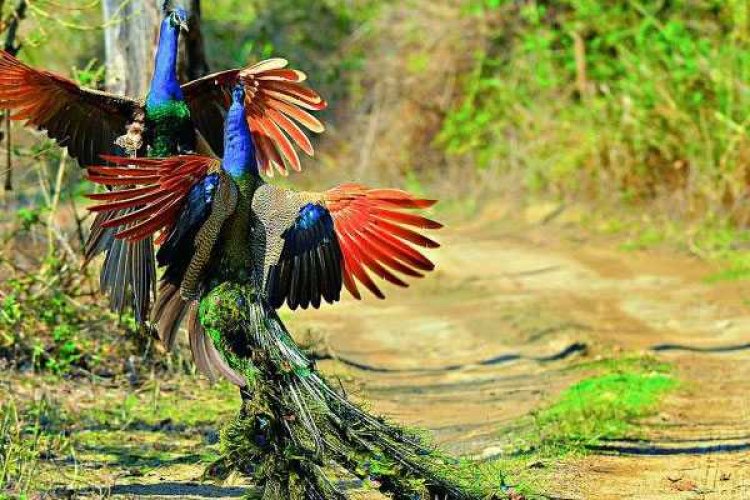Sonanadi Zone: An Overview of Its Rich Biodiversity and Conservation Efforts
The Sonanadi Zone of Jim Corbett National Park is a hidden gem that offers a serene and immersive experience for nature and wildlife enthusiasts. Located in the northern part of the park, this zone is named after the Sonanadi River, which flows through its dense forests and open grasslands.
Share this Post to earn Money ( Upto ₹100 per 1000 Views )

The Sonanadi Zone of Jim Corbett National Park is a hidden gem that offers a serene and immersive experience for nature and wildlife enthusiasts. Located in the northern part of the park, this zone is named after the Sonanadi River, which flows through its dense forests and open grasslands. Known for its incredible biodiversity and conservation initiatives, the Sonanadi Zone is an ideal destination for those seeking the best jungle safari in Jim Corbett National Park while enjoying a quieter, offbeat experience. Let’s delve deeper into what makes this zone so special.
Understanding the Sonanadi Zone
The Sonanadi Zone, part of the Corbett Tiger Reserve, is situated between the Kalagarh and Ramganga rivers. Unlike the more popular Dhikala and Bijrani zones, Sonanadi is less crowded, making it an excellent choice for visitors looking for peace and solitude amid nature. The zone is rich in flora and fauna and provides a safe haven for a variety of wildlife species.
Biodiversity in Sonanadi Zone
-
Flora
The Sonanadi Zone is characterized by dense sal forests, mixed deciduous vegetation, and patches of bamboo. The forests are interspersed with open grasslands and riverine belts, creating a perfect habitat for diverse wildlife species. -
Fauna
The zone is home to: -
Tigers and Leopards: As part of the Corbett Tiger Reserve, Sonanadi supports a healthy population of big cats.
-
Elephants: The majestic Asian elephants are often spotted roaming freely in this area.
-
Birds: Over 550 bird species, including hornbills, eagles, and kingfishers, make Sonanadi a birdwatcher’s paradise.
-
Reptiles: The zone hosts various reptiles, including gharials, crocodiles, and several snake species.
Safari Experience in Sonanadi Zone
Exploring the wilderness of the Sonanadi Zone through a gypsy safari in Jim Corbett National Park is an unforgettable experience. Here’s what to expect:
-
Jeep Safari
The Corbett National Park jeep safari in the Sonanadi Zone allows you to traverse its rugged terrains and scenic landscapes. Guided by experienced naturalists, the safari provides opportunities to spot wildlife in their natural habitat. -
Timing and Duration
Safaris in Sonanadi are conducted twice daily—once in the morning and once in the afternoon. Each safari lasts about three hours, offering ample time to explore the zone’s diverse ecosystems. -
Silent Exploration
Unlike other zones, the Sonanadi Zone is relatively less crowded, allowing visitors to enjoy the sounds of nature without disturbances.
Conservation Efforts in Sonanadi Zone
-
Wildlife Protection
The Sonanadi Zone plays a crucial role in the conservation of endangered species like tigers, leopards, and gharials. Anti-poaching initiatives and strict monitoring have helped maintain the area’s ecological balance. -
Habitat Restoration
Efforts to restore degraded habitats in the zone have been successful in creating a conducive environment for flora and fauna. This includes reforestation projects and water conservation measures. -
Community Involvement
Local communities are actively involved in conservation programs. By promoting eco-tourism and providing employment opportunities, the park encourages locals to become stakeholders in preserving the environment.
Planning Your Visit to Sonanadi Zone
-
Best Time to Visit
The best time to explore the Sonanadi Zone is from November to June, as the park remains closed during the monsoon season. The winter months are ideal for wildlife sightings and birdwatching. -
Booking a Safari
Advance booking is essential for safaris in the Sonanadi Zone. You can reserve your slot online or through authorized tour operators. Remember to carry your ID proof for verification. -
Stay Options
Several accommodations are available near the zone, ranging from luxury resorts to budget-friendly lodges. If you’re looking for a cozy and eco-friendly option, consider a hotel near Sonanadi Zone or a homestay that offers personalized hospitality.
Extend Your Stay at The Corbett Rajae Homestay
After a thrilling safari in the Sonanadi Zone, unwind at The Corbett Rajae Homestay. Nestled amidst lush greenery, this homestay in Jim Corbett provides a perfect blend of comfort and natural beauty. Here’s why it’s an excellent choice:
-
Proximity to Nature: Located near the park, the homestay offers easy access to safari zones.
-
Warm Hospitality: Enjoy home-cooked meals and personalized care from friendly hosts.
-
Eco-Friendly Practices: The homestay emphasizes sustainable living, making it a great choice for eco-conscious travelers.
Conclusion
The Sonanadi Zone of Jim Corbett National Park is a treasure trove of biodiversity and a shining example of successful conservation efforts. Whether it’s the thrill of a gypsy safari in Jim Corbett National Park, the serenity of its landscapes, or the richness of its flora and fauna, the zone promises an unforgettable experience. Enhance your visit by staying at The Corbett Rajae Homestay, where you can relax and reconnect with nature after your adventures. Plan your trip today and discover the wonders of the Sonanadi Zone!















